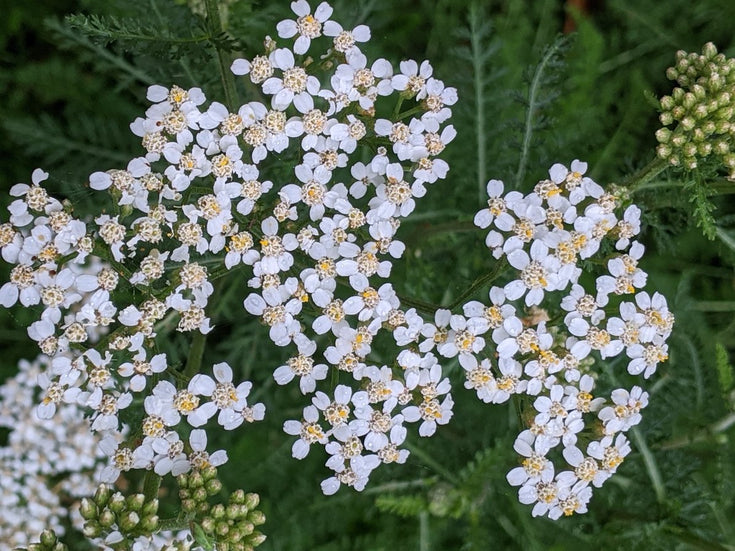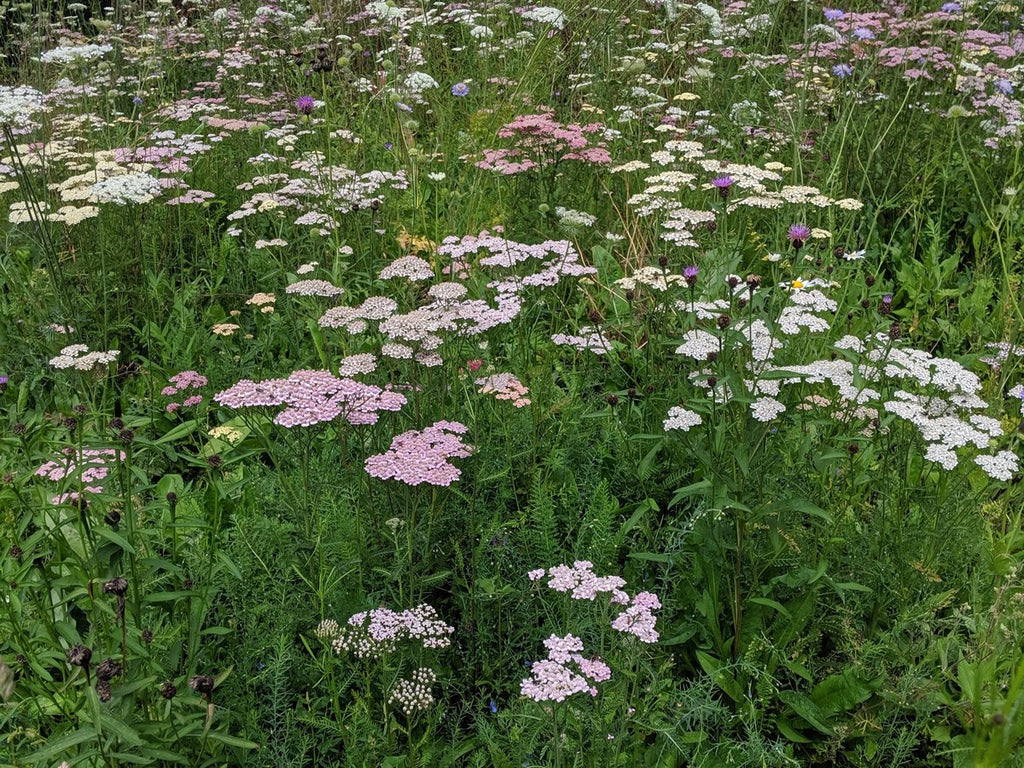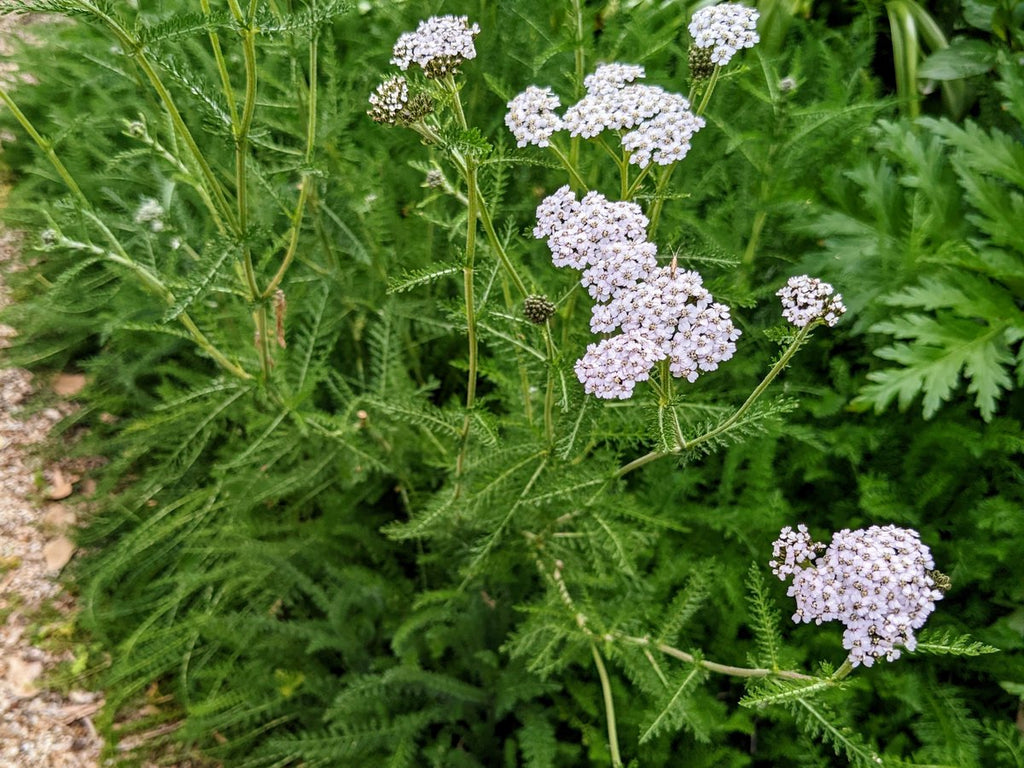Yarrow Guide: History, Growing Conditions, Uses, and More

Yarrow (Achillea millefolium) is a perennial herb that's native to Europe, and renowned for its medicinal properties. Even now, it's used to treat wounds, inflammation, and digestive issues, plus, it can improve the quality of your garden. In the latest version of our Herb Guide species, we delve into yarrow's history, ethnobotanical uses, including its role in ancient Greek, Roman, and traditional Chinese medicine. We'll also share what we've learned from decades of cultivating, propagating, and growing yarrow, as well as the culinary & medicinal benefits that it offers. Ready to learn? Let's dive in!
Name: Yarrow
Botanical Name: Achillea millefolium
Family: Asteraceae
Other names: Milfoil, Soldier's Woundwort, Thousand-leaf, Nosebleed plant, Carpenter's weed Woundwort, Staunch weed, Bloodwort.
French: Achillée millefeuille, Spanish: Milenrama, German: Schafgarbe, Italian: Millefoglie, Hungarian: Csillagfürt, Romanian: Iarba de râu, Dutch: Duizendblad, Polish: Krwawnik pospolity, Bulgarian: Рекавица, Russian: Тысячелистник, Finnish: Siankärsämö, Norwegian: Ryllik, Danish: Røllike, Czech: Měsíček lékařský
Origin: Native to temperate regions of Europe. Yarrow is now found worldwide.
Achillea millefolium is a hardy perennial herb that grows up to 60cm tall when in flower.
Flowers are white or pink and are arranged in a flat-topped cluster at the top of a stem and each flower head is composed of several small disk flowers surrounded by several ray flowers. Flowering time is late spring through summer.
Leaves are long, thin, and feathery, giving the plant a fern-like appearance. Thousands of tiny leaves arranged alternately on the stem look like they have been knitted together. This is an example of the Doctrine of Signatures suggesting that yarrow can knit the skin together. The leaves are aromatic and have a bitter pungent taste.
Other Varieties
There are around 100 different species of yarrow with different varieties in each species making thousands of different yarrow varieties.
- Achillea tomentosa - also known as woolly yarrow, due to the fine hairs on the leaves. Flowers are yellow.
- Achillea filipendulina - tall yarrow with golden yellow flowers, native to central and southwestern Asia
- Achillea clavennae - Central Europe to W. Balkan Peninsula, white flowers very similar to Achillea millefolium
- Achillea ptarmica - native to cold/temperate Eurasia also known as sneezewort as it was used to clear nasal passages by inducing sneezing. It is a lower-growing yarrow with narrow serrated leaves and white flowers.
There are many different hybrids of Achillea millefolium that have been developed for the different coloured flowers. They make a colourful addition to the cottage garden or perennial borders.
- 'Paprika’ - bright red flowers.
- 'Moonshine' - lemon-yellow flowers.
- 'Cerise Queen' - deep pink flowers.
- 'Terracotta' - orange-red flowers
- 'Tutti Frutti' - a mix of bright pink, salmon, and yellow
- 'Summer Pastels' - a mix of pastel-coloured flowers.

Growing Conditions
Yarrow is easy to grow, enjoying a wide range of climates. It will perform best in well-drained soil and full sun although it will tolerate partial shade. Established plants only need water when the soil is dry. Fertiliser is only needed during the initial growing period, although applications of compost and well-rotted manure will benefit the plant once or twice a year. Yarrow plants are hardy and can live for several years with proper care. They will begin to bloom in the second year and produce abundant flowers each summer.
Yarrow can spread aggressively in the garden, so it is important to put it in an area where you are happy for it to spread or keep it contained with a barrier. A pot is also a good option.
Propagation is by division or seed.
Seeds can be sown directly in the garden bed or into seed trays in the spring or autumn. Sprinkle the seeds thinly and evenly over the prepared soil, then cover them with a thin layer of soil (about 3mm). Water gently. Keep the soil moist until the seeds germinate. It can take between 7-14 days for yarrow seeds to germinate.
History and Ethnobotanical Uses
Yarrow has a long history of use as a medicinal herb, dating back to ancient Greece and Rome, where it was used to treat wounds, reduce inflammation, and stop bleeding. It was named after the Greek hero Achilles, who was said to have used it to treat his soldiers' wounds during the Trojan War in 1200 B.C.
It was also used during World War I, and the Civil war in America to treat soldiers' wounds and prevent infection.
In medieval times, yarrow was considered a "cure-all" herb used to treat everything from toothaches to bleeding wounds. It was also believed to have magical properties and was used in spells and divination.
The Druids used the stalks of yarrow to divine seasonal weather.
Yarrow stalks are also used for divination in the I Ching, which is an ancient Chinese text that is used for divination and fortune-telling. In the traditional method of casting the I Ching, 50 yarrow stalks are used to create a series of hexagrams, which are then interpreted to reveal insights about the future or guidance for the present.
In Chinese medicine it is said to have three main actions: clear Exterior Wind (diaphoretic), Tonify Deficiency (tonic) and clear Heart Phlegm (anti-hypertention)
Native American tribes used it to treat a wide variety of ailments, including fever, headache, and digestive problems.
It is used to make beer in Sweden where it is known as Field Hops and believed to create a more intoxicating beer than hops.
Norway's traditional use was to cure rheumatism and as a remedy for toothaches.
Yarrow has been used in traditional Persian medicine for centuries to treat digestive problems, respiratory infections, and skin conditions.
Culinary uses:
Not commonly used in meals because of the bitter, astringent taste. In the past, it was used in small amounts in salads, soups, and stews. They can also be used to flavour beer and other fermented beverages such as mead.

Medicinal Properties
Yarrow has been used for centuries as a natural remedy for various ailments, including fever, colds, flu, digestive issues, and menstrual cramps. It is also a natural astringent and can be used topically to help stop bleeding and promote wound healing.
Part used: the aerial parts, leaf and flower are harvested when the plant is in the early flowering stage. The white of pink/red flowered yarrow are the ones used medicinally, with the white being the most popular. However the pink/red flowers have shown to be higher in flavanoids while the white is higher in volatile oils.
Taste: Bitter and pungent
Constituents:
Yarrow has many, but here are some of the important ones
- Volatile oils: including chamazulene, which has anti-inflammatory and antispasmodic effects.
- Flavonoids: including luteolin and apigenin, which have anti-inflammatory and antioxidant effects.
- Alkaloids: including achilleine, which has a bitter taste and can stimulate digestion.
- Tannins: which have astringent effects on the mucous membranes.
- Coumarins: which have anticoagulant effects.
Medicinal Uses of Yarrow
-
Wound Healing - Yarrow is a natural hemostatic, meaning it can help to stop bleeding. Useful for wounds of all types because it stops bleeding and also has antibacterial and astringent properties that prevent infection. Applying a poulitce of the leaves to a wound can stop bleeding quickly and begin the healing process.
It has been used to treat nosebleeds, heavy menstrual bleeding, and other types of bleeding.
-
Cardiovascular health - Yarrow has been traditionally used for cardiovascular health, and modern research has provided some evidence to support this use. Yarrow contains flavonoids, which have antioxidant and anti-inflammatory properties. These help improve blood flow by dilating blood vessels and toning the vessels that are weak or flaccid. This may result in lower blood pressure and lowers the risk of cardiovascular disease. The toning effect and the ability to move stagnant blood also help to reduce varicose veins and hemorrhoids.
Additionally, it may help reduce cholesterol levels, another risk factor for cardiovascular disease. For example, one study found that a yarrow extract reduced total cholesterol and LDL (bad) cholesterol levels in rats with high cholesterol levels.
Yarrow can be used alone or with other herbs for cardiovascular health. Hawthorn, another popular cardiovascular herb, is often used with yarrow.
-
Menstrual health - Yarrow can also be useful for regulating the menstrual cycle. It can help to reduce heavy bleeding and promote the healing of any tissues that may have been damaged. Its anti-inflammatory and spasmolytic properties help relax smooth muscles and bring relief to cramping.
-
Urinary disorders - cystitis and urethritis can be relieved with the diuretic and antimicrobial action of yarrow. It increases urine production to flush out the urinary system, reduce inflammation and fight off infections. As well as taking yarrow internally, a sitz bath can help soothe and reduce inflammation in the urinary area.
-
Arthritis and Gout - used internally as a tea or tincture or externally as a poultice or compress yarrows' anti-inflammatory properties help to reduce joint inflammation and alleviate pain associated with arthritis and gout.
-
Digestion - Yarrow is a bitter herb that can help to stimulate digestion and improve the absorption of nutrients.
-
Fever - Yarrow is a versatile herb that has both stimulant and relaxant diaphoretic properties. The volatile essential oils found in yarrow help to stimulate blood flow and circulation, while the flavonoids and other compounds work to relax tension in the blood vessels. This combined action of circulatory stimulant and diaphoretic promotes sweating and aids in heat, leaving the body helping to break a fever.
-
Cold and Flu - a mucous membrane tonic due to its astringent action and the anti-catarrhal properties from the volatile oils help with congestion and excess mucous in the body, bringing relief to the symptoms of colds, flu, asthma and bronchitis
- Immune support - while not a specific immune herb, it combines nicely with other herbs such as Elderflower and peppermint or Echinacea.
Medicinal Preparations with Yarrow
Tea/Tisane: 1-2 tsp (2-4g) of dried yarrow to 1 cup of boiling water. Cover the cup to stop the evaporation of the volatile oils. Standard dose 3 times a day. For fever can be taken hourly.
YEP Tea is a traditional blend of equal parts of yarrow elderflower and peppermint used for colds, flu and fever. We sell this blend as Cold and Flu Tea
- Yarrow - reduces fever and inflammation
- Elderflower - reduces fever, catarrh and inflammation and tones the mucous membranes
- Peppermint - decongestant and relieves the headache associated with cold & flu
Tincture: A 1:5 tincture made with 1 part of dried yarrow to 5 parts by volume of 45% alcohol. 2-4ml taken three times a day with water or juice.
Poultice: Fresh leaves can be either chewed (spit poultice) or pounded and applied to the area of concern. Dried leaves can be moistened or powdered first, then moistened and applied to the area. A piece of thin finely woven gauze can be placed on a wound first then apply the paste to help keep the wound clean.
Compress: You can use a strong water infusion or diluted tincture of yarrow for a compress. Dip a cloth in the infusion/tincture and then place over the affected area.
Stitz bath: You will need a basin big enough so that you can sit in it comfortably with the water level coming up to cover the kidney area.
To make a stiz bath put 1 cup of dried yarrow in a pot and cover it with a litre of boiled water. Put the lid on and let it sit for 15 min. Strain into the basin and top it up with cooler water to a temperature that will not burn you. Sit in the stitz bath for 15-20 minutes.
Contraindications:
Can cause allergic reactions in people sensitive to the Asteraceae family.
Yarrow should be used with caution during pregnancy and lactation.
All information provided in this email is for informational purposes only. Please seek professional advice before commencing any treatment.
Other Uses
Flower Arrangement: Yarrow flowers look beautiful in fresh or dried flower arrangements. They dry well by hanging the flowers from the bottom of the stem to keep them straight. Dry in small bunches in a warm airy position.
Plant Dye - Yarrow can also be used as a natural dye to create a range of yellow to brownish-yellow colours on natural fibres such as wool, cotton, silk, and linen. The flowers and leaves of the plant contain a yellow pigment called chamazulene, which is responsible for the colour.
Astrology - In astrology, yarrow is associated with the planet Venus, which represents love, beauty, and harmony. Yarrow is believed to have a calming and soothing energy and can be used to promote love and compassion. It is also associated with the zodiac sign of Aries, which is known for its courage, strength, and determination.

Garden Benefits of Yarrow
Yarrow is a versatile plant that can be used in many different garden styles and settings. Its adaptability and hardiness make it a reliable choice for any gardener looking to add beauty and biodiversity to their landscape.
Cottage Gardens - Yarrow, with its delicate flowers and fern-like foliage, makes it a perfect addition to a cottage garden's informal, romantic style. It can be planted among other perennial flowers and herbs for a colourful and fragrant display.
Pollinator gardens - Yarrow is highly attractive to bees, butterflies, and other pollinators, making it a great choice for a garden designed to support these important insects. It can be planted in large drifts or mixed with other pollinator-friendly plants to create a diverse and thriving habitat.
Companion Planting - Its natural insect-repelling properties from constituents such as chamazulene and azulene make it useful as a companion plant to deter pests from other nearby plants. It is especially helpful when planted near vegetables such as tomatoes, peppers, and eggplants, which are often targeted by pests like aphids and flea beetles.
A spray can also be made steep a handful of fresh or dried yarrow leaves and flowers in a quart of boiling water for several hours. Strain the mixture and transfer it to a spray bottle. Spray the mixture directly onto the plants that are being attacked by pests. You may need to repeat this process several times a week for the best results.
Compost - Yarrow is a dynamic accumulator, meaning it can absorb nutrients from the soil and make them available to other plants. A handful of leaves and stems can be added to the compost to speed up the decomposition process and add valuable nutrients to the finished compost. Yarrow contains high potassium levels, an essential nutrient for plant growth and development.
Biodynamics - Yarrow is used in preparation 502, one of several preparations used in biodynamic farming this preparation. The preparation is made by filling the bladder of a female red deer with fresh yarrow flowers and burying it in the ground over the winter. The bladder is then dug up in the spring, and the contents are diluted in water and then sprayed over the soil or plants. 502 helps to stimulate and balance the plant's etheric or life force energy, which in turn enhances the plant's ability to absorb and utilize nutrients, particularly potassium and sulphur, from the soil. It also enhances plants' resistance to disease and pests.



